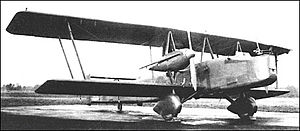Vickers Vanox Video - Picture

|
|
Vickers Vanox
Vanox

Role: Bomber
Manufacturer: Vickers
First flight: 30 November 1929
Number built: 1
The Vickers Vanox was a British biplane bomber design intended as a successor to the Virginia for the Royal Air Force. Although it underwent extensive development, it was not successful, only a single aircraft being built.
Design and development
Conceived as a biplane powered by the Bristol Jupiter radial engine it would have much better performance than the Virginia with similar engines. Initially a private venture, the submission of Vickers design to the Air Ministry coincided with the issuing of Air Ministry specification B.19/27 for a Virginia replacement.
The B.19/27 specification meant that the Vickers submission would be tested competitively in trials against other manufacturer's designs. In the redesign to meet the specification, the B.19/27 project took the Virginia Mark X all moving rudder together with an all-moving tailplane. Three designs were submitted in total; two biplanes with Jupiter and geared Bristol Mercury engines respectively and a monoplane version. The Mercury engined design, the Vickers Type 150 was selected by the Ministry for consideration and building, now to be funded by the Ministry, started. Part way through it was agreed that an alternative engine was allowable, the Rolls-Royce F.XIV (later developed into the Rolls-Royce Kestrel).
The aircraft flew for the first time on 30 November 1929. The aircraft was a two-bay biplane of all metal construction, with a biplane tailplane and with the two engines mounted between the wings.
Initial testing and evaluation showed that the aircraft had poor handling, being unstable laterally, prone to Dutch roll and to severe flexing of the rear fuselage. Following an forced landing it was rebuilt incorporating recommendations made in reports from Ministry test pilots to try and resolve these problems, and was powered by Kestrel III engines. It was then given the name Vickers Vanox by Vickers.
These changes did not solve the aircraft's handling problems, and the sweepback of the wings was reduced, which resolved the handling problems. The Kestrel engines proved unreliable , and were replaced by more powerful Bristol Pegasus radial engines. In this form, the aircraft was designated the Vickers Type 195 Vanox, and was demonstrated to meet the requirements of specification.
Following further modifications in February 1933 to improve performance, with extended, three bay wings being fitted, it was now designated the Type 255. However, by this time, the competing Handley Page Heyford and Fairey Hendon bombers had already been ordered into production, so the sole Type 255 was used for aerial refuelling trials work by the Royal Aircraft Establishment, being flown for the last time on 7 January 1938.
Specifications (Type 150)
Data from The British Bomber since 1914
General characteristics
Crew: 4
Length: 60 ft 6 in (18.45 m)
Wingspan: 76 ft 6 in (23.32 m)
Height: 19 ft 3 in (5.87 m)
Wing area: 1,367 ft² (127 m²)
Airfoil: RAF 34
Empty weight: 10,435 lb (4,743 kg)
Loaded weight: 15,400 lb (7,000 kg)
Max takeoff weight: 16,170 lb (7,350 kg)
Powerplant: 2x— Rolls Royce F.XIV V-12 piston engine, 480 hp (358 kW) each
Performance
Maximum speed: 125 mph (109 kn, 201 km/h)
Range: 920 mi (800 nmi, 1,481 km)
Service ceiling: 23,000 ft (7,000 m)
Wing loading: 11.3 lb/ft² (55.1 kg/m²)
Power/mass: 0.062 hp/lb (0.10 kW/kg)
Climb to 6,500 ft (1,980 m): 19 min 45 sec
Armament
Guns: 2 x— .303 in (7.7 mm) Lewis Guns
Bombs: Up to 2,200 lb (1,000 kg) of bombs
Comparable aircraft
Handley Page Heyford
Fairey Hendon
Andrews, E.N.; Morgan, E.B. Vickers Aircraft Since 1908, London: Putnam, Second Edition, 1988. ISBN 0-85177-815-1.
Mason, Francis K. The British Bomber since 1914. London: Putnam Aeronautical Books, 1994. ISBN 0-85177-861-5.
Vickers Vanox Pictures
Living Warbirds: The best warbirds DVD series.
Source: WikiPedia